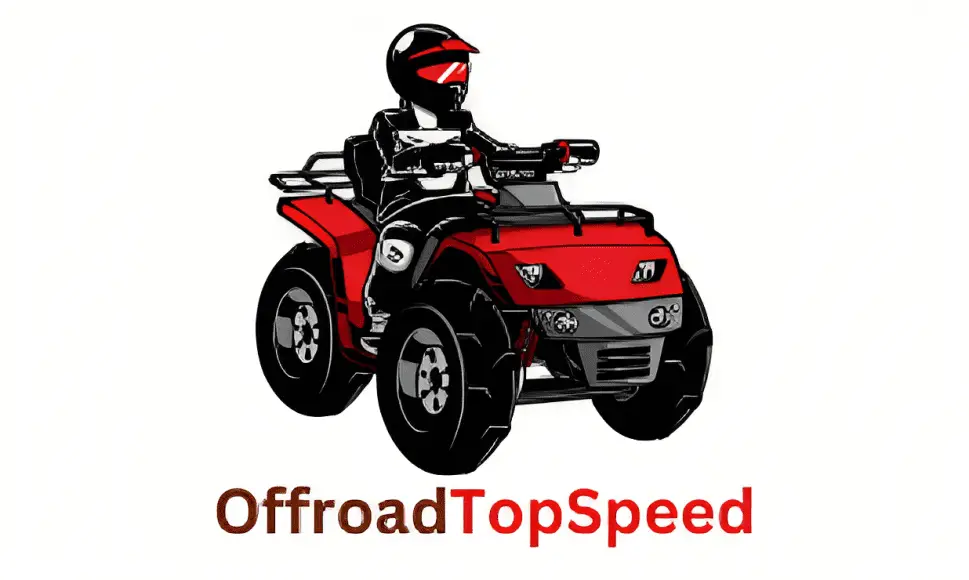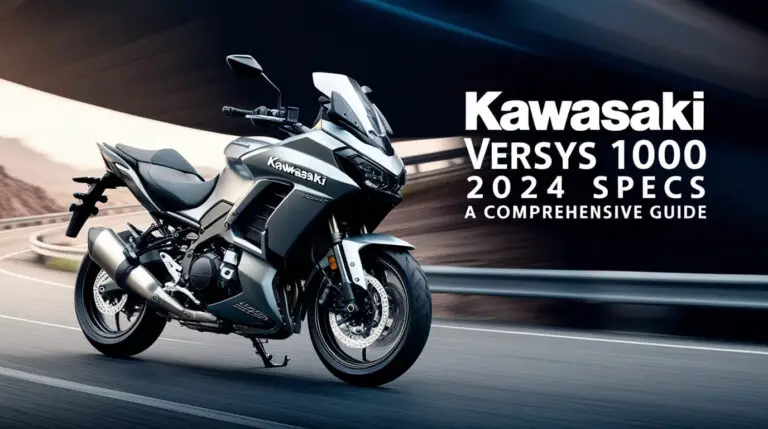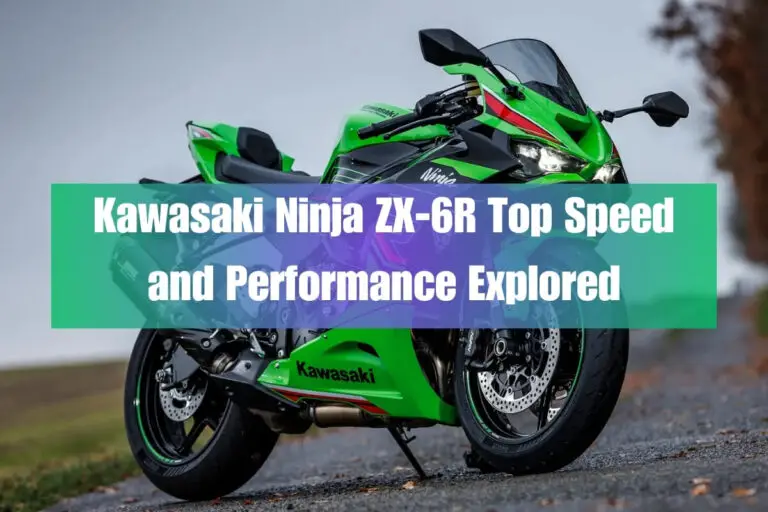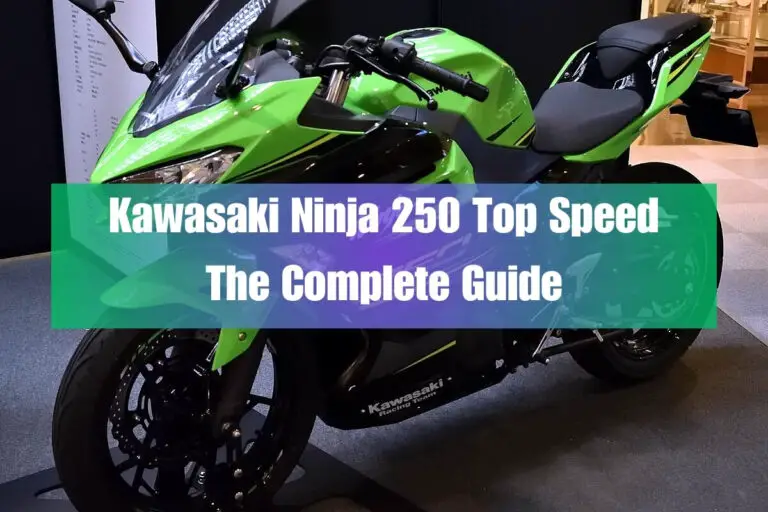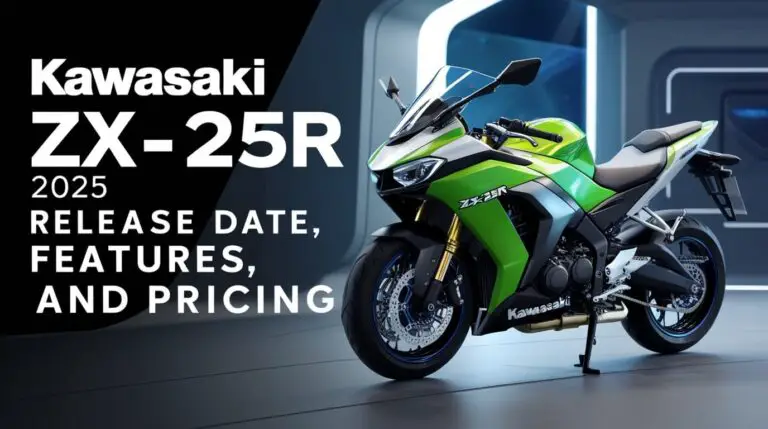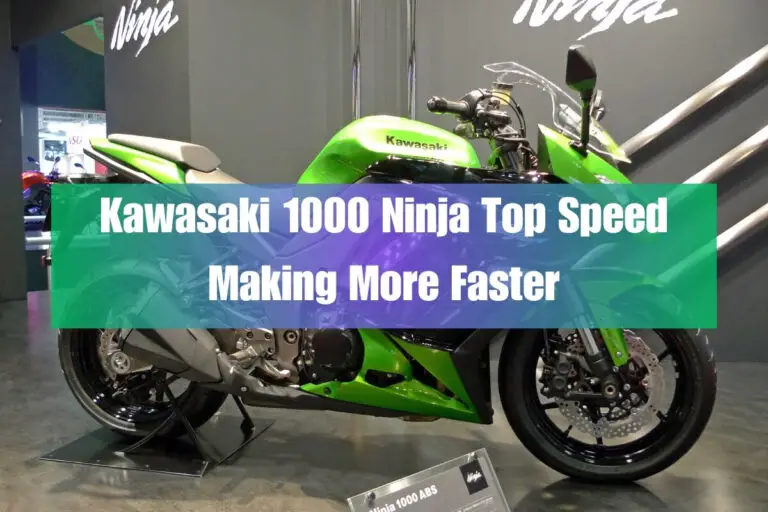Kawasaki Ninja 300 Top Speed: Tested Speed & Acceleration
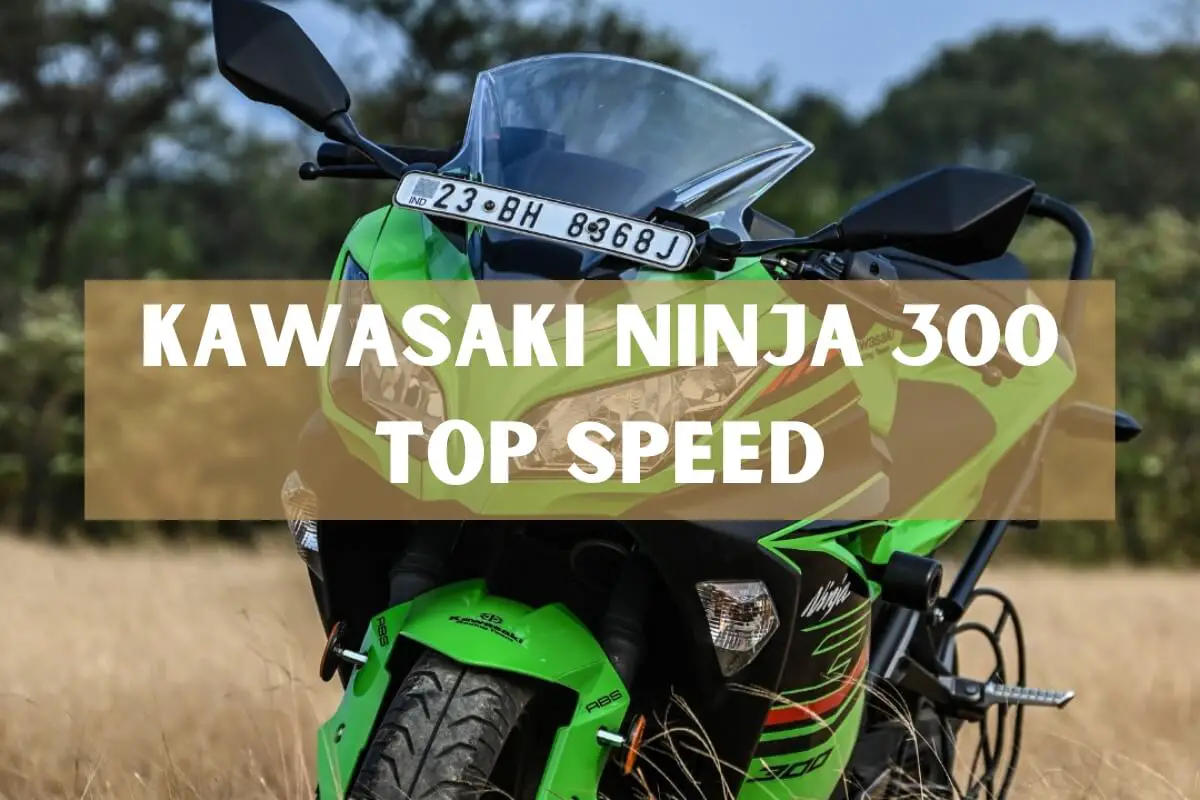
The Kawasaki Ninja 300 is one of the most popular and iconic entry-level sportbikes on the market. With its sharp styling and great handling, it’s often the first taste of the supersport experience for new riders. But a common question asked by both new and experienced riders alike is: Is the little Ninja 300 powerful and fast enough?
The short answer: Yes, the Kawasaki Ninja 300 is fast enough for most riding applications and its top speed is 110 mph. Read on as we dive into real owner experiences with acceleration and top speeds, and explore how the Ninja 300 compares to other bikes in its class.
In this detailed deep dive, we’ll cover everything you need to know about what speed you can expect from the 300 on public roads, comparisons to rivals like the Yamaha R3 and KTM RC390, whether upgrades can make it faster, and what owners have to say about its real-world pace and excitement factor. Let’s get into it!
Kawasaki Ninja 300 Overview
First, let’s recap what exactly is the Kawasaki Ninja 300 and who it is designed for. Debuting for the 2023 model year, the Ninja 300 continues Kawasaki’s history of entry-level sport bikes using a 296cc parallel twin engine.
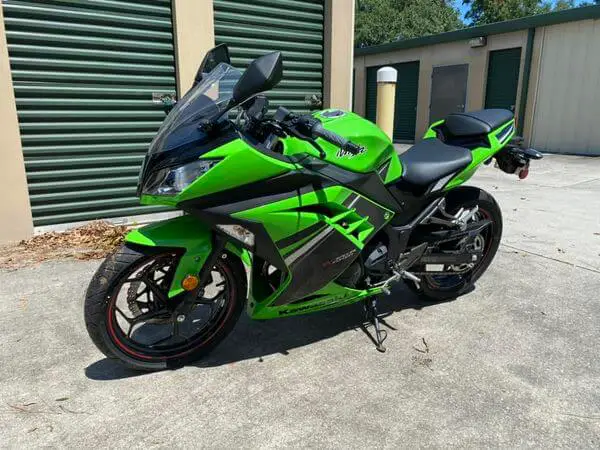
Often called the Kawasaki Ninja 300 ABS, for its available anti-lock brakes, or simply the Ninja 300 in singular, this lightweight machine utilizes sharp, Ninja-family styling in a slim and unintimidating package. Now upgraded to Euro 5 emission standards, it quickly became one of the best selling and well-regarded bikes on the market when it was first introduced.
| Specification | 2023 Kawasaki Ninja 300 |
|---|---|
| Top Speed | 110 mph |
| Price | $4,999 MSRP |
| Engine | 296cc, 4-stroke, Liquid-cooled, DOHC Parallel Twin |
| Bore x Stroke | 49.0 mm x 62.0 mm |
| Compression Ratio | 10.6:1 |
| Max Power | 39 hp @ 10,500 rpm |
| Max Torque | 19.3 lb-ft @ 10,000 rpm |
| Starter | Electric |
| Transmission | 6-speed |
| Final Drive | Chain |
| Front Brakes | Single 290mm Petal Disc |
| Rear Brakes | Single 220mm Petal Disc |
| Front Suspension | 37mm Telescopic Fork, 4.7 in Travel |
| Rear Suspension | Bottom-Link Uni-Trak, 5-Way Preload, 5.2 in Travel |
| Front Tire | 110/70-17 |
| Rear Tire | 140/70-17 |
| Wheelbase | 55.3 in |
| Seat Height | 30.7 in |
| Wet Weight | 394.6 lbs |
| Fuel Capacity | 4.5 gallons |
The Ninja 300 features a 296cc, liquid-cooled, parallel-twin engine. It mates to a smooth-shifting 6-speed transmission and makes use of an assist and slipper clutch for reduced effort and rear wheel hop during aggressive downshifts.
With its slim dimensions, unintimidating seat height, and lightweight feel, the bike was clearly targeted toward newer riders looking for their first sporty motorcycle or small-statured riders seeking confidence-inspiring ergonomics. Its 296 cc twin has enough grunt for quick bursts of speed while maintaining a friendly and forgiving power delivery.
When paired with its nimble, flickable chassis and responsive handling, the Ninja 300 became renowned as an ideal machine for navigating through tight city streets or carving up winding backroads. It was billed by many outlets as the ultimate lightweight, confidence-building entry-level sportbike.
Ninja 300 Top Speed and Acceleration
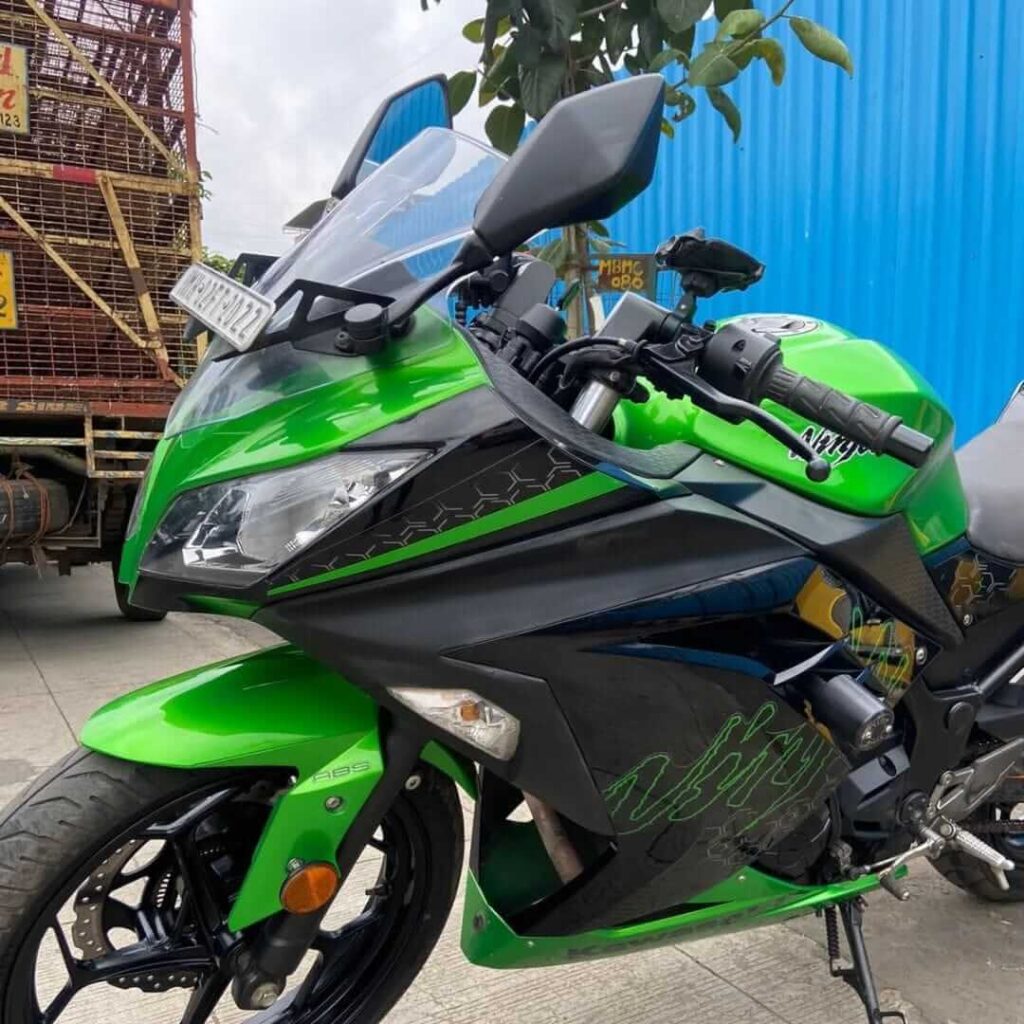
Now that we understand the bike’s intended purpose, let’s get into the good stuff and talk about how fast the plucky little 296cc Ninja can really go.
What is the Official Top Speed Rating?
In stock factory trim with no performance modifications, the 2023 Ninja 300 has an official top speed rating of 110 mph (177 km/h).
For a lightweight beginner bike, over 100 mph is quite rapid indeed! While far short of the 180+ mph capabilities of its 600-1000cc supersport cousins, keep in mind the Ninja 300 is powered by an engine less than 30% the displacement of those machines. Plus that triple digit top speed figure is much more than usable in legal public road riding.
0-60 mph and Quarter Mile Acceleration
In addition to its triple digit top end virtues, the latest test data shows the Kawasaki Ninja 300 reaching 0-60 mph in 5.23 seconds and running the quarter mile in the mid 14 second range.
Again, very quick numbers for a 296cc twin! Of course, a Ninja ZX-10R or other hypersport machine does the deed faster, but they also cost 3-4 times as much. For a beginner-friendly, small-displacement bike, that’s seriously swift acceleration – especially considering its sub-400 pound curb weight.
How Does it Compare to Other 300cc/400cc Sportbikes?
The Ninja 300 exists in an increasingly competitive market segment of lightweight beginner sportbikes in the 300cc to 400cc range. How does its straight line performance measure up against key rivals? Very favorably based on the latest comparisons below!
- Yamaha YZF-R3: The YZF-R3 does have a slight power advantage over the Ninja 300, with a higher horsepower rating. However, the Ninja 300 competes well with similar acceleration times and top speed.
- KTM RC 390: The RC 390 indeed has a peak power advantage over the Ninja 300, which can translate to slightly better performance in certain conditions. However, in real-world riding, the difference in pace is often negligible due to various factors like rider skill and road conditions.
- Honda CBR300R: The CBR300R is less powerful than the Ninja 300, which generally makes it a touch slower in terms of straight-line performance.
The Kawasaki Ninja 300 is known for its balance of performance and rider-friendly characteristics, making it a strong contender in its class. It offers a good mix of speed, agility, and approachability for new riders, while still providing enough excitement for more experienced motorcyclists. Overall, your statement captures the essence of the Ninja 300’s competitive stance in the market.
What Speed is Realistic on Public Roads?
Okay, you’re saying, over 100 mph sounds fantastic…but will I actually go that fast?!
It’s true, triple digit velocities are not legal or recommended on public highways. So what speeds can you reasonably expect to see on the Ninja 300 speedometer out in the real world?
Kawasaki Ninja 300 Top Speed Expectations
The tachometer of your average passenger vehicle typically ends around 120-130 mph, though many family cars will run out of steam well before hitting that figure. For a motorcycle weighing less than half of a compact car and powered by a revvy twin-cylinder engine, the story tends to be different.
Ninja 300 riders report seeing indicated speeds up to 110-115 mph on long highway stretches when conditions allow. More common are spurts between 80-95 mph when traffic permits. Even sustained 70-90 mph cruise speeds feel smooth and comfortable thanks to the bike’s wind-tunnel developed fairings.
Height, weight, gearing, and other factors mean your results may vary. But suffice to say, the Ninja 300 has plenty of top speed capabilities for legal public road riding, with power to spare for getting out of harms way when needed. You’ll never feel handicapped by a lack of acceleration or passing might.
Real-World Speed Capabilities
When speeds do begin creeping up past 100 mph, mechanical turbulence and wind resistance start taking a toll. The Ninja 300 remains composed, but acceleration tapers off significantly.
Blasting from 70 mph to its 110 mph top speed takes determination. Accelerating much past 105 mph feels like you’ve hit a wall in terms of usable power. Exceeding the bike’s limits requires a long stretch of wide open road and a tightly tucked posture.
Unless riding on a closed course, we recommend obeying all speed limits and riding within your skill level on public roads! The Ninja 300 provides exhilarating real-world pace while staying precisely on the legal side of fun.
Does it Feel Fast Enough?
Okay, we’ve established the Kawasaki Ninja 300 has impressive top speed and acceleration capacities relative to its small displacement. But do those stats translate into a sufficiently thrilling riding experience? What do owners have to say?
Grins Between the Ears
The seat of your pants does not always align with instruments and spec sheets. While over 100 mph sounds fast, some riders worry a “beginner bike” will still feel boring. Thankfully, that’s not the case with the latest Ninja 300!
Owners rave about the bike’s exciting sense of speed and eagerness to rev to redline. The parallel-twin loves building rpm and pushes strong through its midrange. Whipping along backroads triggers all kinds of grins.
The smooth powerband, intake howl, and nimble handling make the 300 downright riotous when ridden actively. It’s no liter bike, but far more thrilling than its entry-level label suggests.
Here’s what some happy new Ninja 300 owners have to say:
“I’m amazed at the acceleration and speed I can carry. Easily keeps highway pace and leaves cars behind when I downshift.”
“Faster than it has any business being! I scare myself keeping up with buddies on supersports.”
“Carving canyons is an absolute blast. Super quick handling and throttle response never feels underpowered.”
What Determines the Kawasaki Ninja 300’s Top Speed?
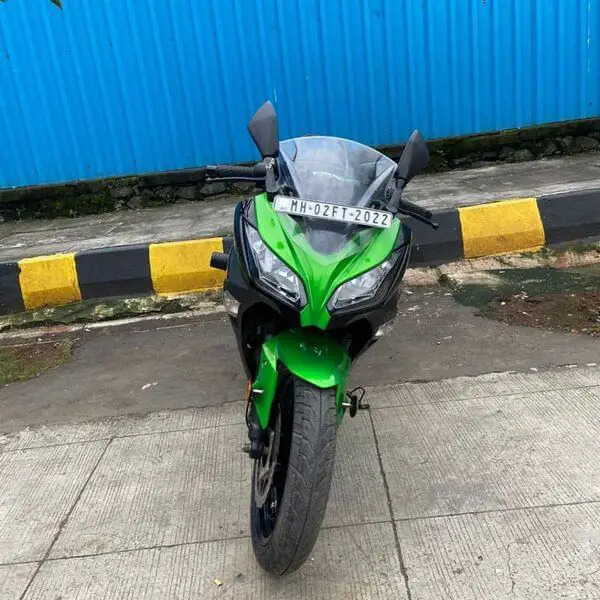
We’ve established by now that the Ninja 300 has serious speed potential relative to its petite stature and beginner friendly billing. But what mechanical factors actually determine how fast this motorcycle can go?
Engine Power and Gearing
The Ninja 300’s parallel twin engine utilizes an oversquare configuration, meaning its bore and stroke measures 49 mm x 62 mm. This allows it to safely rev to its 12,000 rpm redline to generate peak power. In stock form, max horsepower arrives at 10,500 rpm.
This 296cc motor churns out 35 hp at the crank. While not huge power in absolute terms, that figure comes from an engine displacing less than 300cc – similar to many scooters! Specific output equates to over 118 hp per liter.
Gearing also plays a role. The 300 features a 6-speed transmission with well spaced ratios. This keeps the engine in an optimal rpm range as speeds rise. The transmission itself is smooth, never misses a shift, and works well with the back torque assist and slipper clutch.
Chassis and Aerodynamics
The trellis frame, 37mm front forks, and preload adjustable rear shock provide a balanced, sporty chassis for confident handling. Stylish full-fairing bodywork with twin headlights draws inspiration from Kawasaki’s supersport models. This aerodynamic shape cuts through air smoothly, allowing triple digit speeds.
Ways to Make the Ninja 300 Faster
Even in stock form, the perky Ninja 300 can hold its own against rivals and boasts a smile-inducing riding experience. But what if you’re looking for even more performance? Thankfully, there are options to extract more speed from your Kawasaki through targeted modifications.
Exhaust Upgrades
Popular options include slip-on or full systems exhausts, often in stainless steel or carbon fiber. Less restrictive exhausts unleash more power by reducing backpressure. Owners report livelier throttle response from exhaust changes alone.
When combined with other mods, you may see 1-2 hp gains up top. More importantly, the improved soundtrack enhances the riding experience! Check local noise regulations first.
Airbox and Filters
Less restriction on the intake side can also free up horsepower. Swapping the air filter for an oiled cotton gauze style, or better yet a tapered K&N air filter, allows more airflow into the combustion chambers. Even bigger gains come from opening up the airbox to gulp more oxygen.
Fuel Mods
Whether it’s bumping up the fuel pressure, adding a Power Commander to tweak fueling maps, or installing a more advanced ECU flash, all help optimize combustion. Providing enough fuel and the proper air/fuel ratios is key to making the most power possible from engine internals.
Final Drive Sprocket Change
Recall that gearing has a big influence on acceleration and maximum speed capabilities. Installing one or two teeth larger front sprockets effectively shortens gear ratios across all six speeds. This equates to snappier throttle response and higher realized top speeds when conditions allow.
Kawasaki Ninja Model Top Speed Comparison
| Model | Top Speed |
|---|---|
| Kawasaki Ninja 250 | 95–105 mph |
| Kawasaki Ninja 300 | 110 mph |
| 2018 Kawasaki Ninja 300 | 112 mph |
| Kawasaki Ninja 400 | 116.7 mph |
The Kawasaki Ninja 300, even in 2018 trim, is officially rated over 100 mph top speed thanks to its high revving 296cc parallel twin engine. The Ninja 250 makes a still impressive 105 mph max speed from just 250cc. Stepping up to the Ninja 400 gains you around 20 mph higher top end capabilities.
As you can see, there is a nice progression of peak velocity across the lightweight Ninja range. Each model offers excellent acceleration and real world speed to match its sporty look and handling prowess. New riders will appreciate the unintimidating ergonomics and friendly power delivery, while having headroom to grow into. And with triple digit top speeds, none of these bikes will leave you wanting for straight line performance!
Kawasaki Ninja 300 Pros and Cons
Before wrapping up, let’s summarize the standout positives and negatives of Kawasaki’s venerable Ninja 300 as discovered throughout our analysis:
Pros
- Triple digit top speed from a 296cc parallel-twin
- Swift acceleration for a small entry-level sportbike
- Attractive color options including Kawasaki Lime Green
- Easy ergonomics for new riders
- Nimble handling and braking performance
- Huge aftermarket support for mods
- Excellent 70+ mpg fuel efficiency
Cons
- Not the sharpest turn-in vs rivals
- Budget components in some areas
- 4.5 gallon tank limits range
- Less adjustability than premium bikes
- Lacks IMU or traction control electronics
- Some vibes and buzziness inherent to twin
The Ninja 300 delivers excellent real-world performance stats despite its entry-level friendly billing and price point. It remains one of the best options for new riders seeking a lightweight, yet quick sportbike.
Conclusion: The Ninja 300 is Plenty Quick!
We’ve covered a full spectrum of topics examining real world acceleration, top speed capabilities, and the overall riding experience offered by Kawasaki’s immensely popular Ninja 300 sportbike.
Here are the key conclusions:
- Independently tested top speed of 110 mph – Seriously fast for a sub-300cc parallel-twin
- 0-60 mph in 5.23 seconds matches bigger bikes
- Nimble handling belies its friendly ergonomics
- High-revving motor loves to scream near redline
- Owners praise thrilling real-world pace
The Ninja 300 retains the easygoing temperament that’s made it a top choice for beginning riders, while boasting straight line performance once reserved for larger machines. Given its blend of unintimidating dimensions, agile handling, and vocal powerplant, Kawasaki’s quarter-liter Ninja has all the velocity you need for public road use. And then some!
Look beyond the modest displacement – the Ninja 300 has genuine sportsbike speed potential. This iconic machine carries the Ninja torch in miniature form. Rest assured its smiles per mile ratios exceed the spec sheet. Just try not to scare yourself with the pace!
